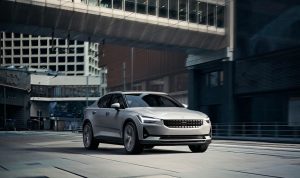The question is, will customers care? Honda is certainly confident. “Our official story is that it’s quite a unique car,” said energy management head Jorgen Pluym. “While the Zoe will have some similar use cases, we think that with all the tech in this car, it has an additional appeal that justifies the higher price tag.”
The sportiness and high-tech interior make the Honda E an attractive car, but when it comes to energy management, Honda is telling a story that more mature EV companies have given up on.
“This car is really meant for urban environments, and has a small battery package that makes it much more nimble and agile, and that is really the concept of this car,” said Pluym. “Most people commute and go to town and go shopping, and you can charge at home every night, so there’s no need to carry a larger battery for most people.”
To that end, Honda is working with Ubitricity in the UK to get access to around 1,800 chargers installed in light posts around the UK. That’ll make it a lot more practical to own a Honda E in the city, without the need for a garage or remote public charger.
However, that was Renault’s pitch for the Zoe when it had a 41 kWh battery pack. Then, due to consumer demand, the French car manufacturer enlarged it in 2019 to 52 kWh to make it more versatile. At the same time, it has kept the same price.
It might be better to look at the Honda E as the first step for a notoriously conservative car company. Connectivity boss Mirai Aki said that the project faced headwinds from the very start and laughed when a journalist asked if the project was “fun.” Instead, the design team struggled against upper management, particularly since Honda has been so adamantly against EVs over the last half a dozen years, instead pursuing hydrogen and other tech.
“There were a lot of people [inside Honda] against this project,” he said. “When you’re receiving all those critical comments from the board, you feel like you’re being treated badly.”
Luckily, they persisted and managed to find a formula to gain public support for the project while turning out a vehicle that seems to justify the premium, despite the lack of range. Taking that unconventional approach also allowed them to turn the E into a calling card for Honda’s fledgling Vision 2025 electrification program. By focusing on design, driving fun and technology, Honda is betting its biggest fans will pay a premium for an EV that’s different from everything else on the market.
After spending some time with the Honda E in Frankfurt, I think the company appears to have made a wise choice. The wow factor with the EV, both from the inside and outside, is very high. The futuristic interior, voice control and other tech actually looks like it will be enjoyable and even practical for the digital natives it’s aimed at. And many of those folks do live in cities where the car makes the most sense.
While Aki admitted there’s room for improvement in the pricing, the designers were satisfied with the final result. “We wanted to demonstrate Honda’s capability in looks, technology and driving ability,” he said. “All that criticism drove us to bring something completely different. That’s what we wanted to express with that car.”
Update 9/11/2019 7:35 AM ET: The prices shown in the article have been updated to reflect the prices after the government grant for both the Honda E and Renault Zoe. The original article showed the Honda E as costing £3,000 ($3,500) more than the Zoe, which is not the case.
All products recommended by Engadget are selected by our editorial team, independent of our parent company. Some of our stories include affiliate links. If you buy something through one of these links, we may earn an affiliate commission.

Comments

72
Shares




